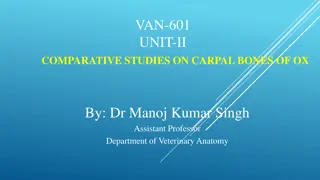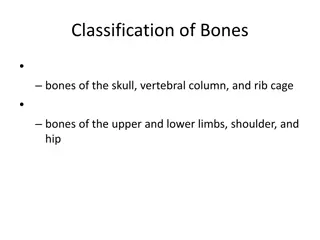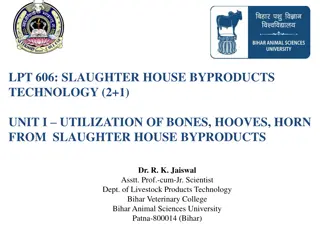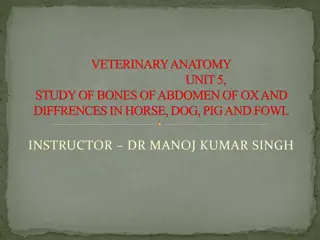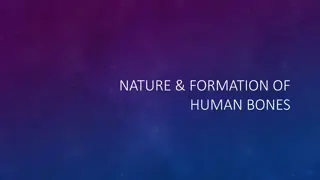Understanding Bone Anatomy and Composition
Explore the intricate details of bone structure and function, from the classification of bones by shape to the constituents of bone tissue. Learn about the essential role bones play in providing structural support, protection, and blood cell production. Delve into the anatomy of long and flat bones,
7 views • 31 slides
Ethical Dilemma of the Illegal Bone Trade in India
PowerPoint slides shed light on the unethical history and persistent issue of the illegal bone trade in India, questioning the ethical implications of using bones from questionable sources in education. The trade's colonial roots, lack of consent, and profiting from the vulnerable raise concerns abo
1 views • 4 slides
Best Knee Replacement Surgeons in India
Knee is the largest joint of the human body, it is a hinge joint which allows flexion and extension and also slight internal and external rotation. It connects our thigh to our lower leg. Similar to all other joints, the knees are part of our skeletal system. The knee helps to support our weight. It
0 views • 2 slides
Comparative Studies on Carpal Bones of Ox
The carpus of ox consists of six bones arranged in two rows - four in the proximal and two in the distal rows. These bones include the radial carpal, intermediate carpal, ulnar carpal, accessory carpal, and fused second and third carpal bones. Each bone has specific features and articulations contri
1 views • 14 slides
Understanding Tarsal Bone Anatomy in Veterinary Science
Tarsal bones in veterinary anatomy play a crucial role in the structure of an animal's hind limbs. Comprising five short bones arranged in distinct rows, including the tibial, fibular, and central tarsals, the tarsus supports movement and stability. The largest tarsal, known as the calcaneal tubercl
1 views • 24 slides
Innovative Makeup Application Device for Bilateral Upper Limb Amputees
Proposed solution entails a makeup application device designed for bilateral upper limb amputees, enabling independent makeup application. The device incorporates three components: an intermediary device, makeup brush end-effectors, and a change-out station/makeup case. Addressing the need for empow
0 views • 22 slides
Exploring the Human Skeletal System
The skeletal system is crucial for protecting organs, providing structure for movement, storing minerals, and producing blood cells. It consists of the axial and appendicular skeleton, with bones classified into long, short, flat, and irregular shapes. Long bones, such as the femur, play a key role
2 views • 28 slides
Understanding Bones: Classification, Functions, and Markings
Explore the classification of bones based on shape, learn about the functions of bones in supporting the body and protecting vital organs, and understand the different bone markings that serve as attachment sites and joint formations.
1 views • 34 slides
Adaptation of Animals to Hot Climates - Understanding Thermal Regulation Strategies
Animals have evolved remarkable adaptations to cope with hot climates, including physiological responses such as sweating and changes in body size and limb length. Temperature stress can affect their functioning, making thermoregulation crucial. Bergmann's rule and Allen's rule explain how body size
0 views • 15 slides
Utilization of Bones, Hooves, and Horn from Slaughterhouse Byproducts
Bones, hooves, and horns from slaughterhouse byproducts hold significant value and can be utilized for various purposes. Bones contain organic and inorganic matter, with applications in manufacturing, poultry feeds, and pottery. Hooves and horns contribute to gelatine and glue production, derived fr
0 views • 42 slides
Understanding the Brachial Plexus Anatomy and Function
The brachial plexus is a crucial network of nerves in the upper limb, formed by nerve fibers originating from C5 to T1 spinal levels. It plays a significant role in innervating the upper extremity muscles and providing sensory feedback. The plexus is categorized into roots, trunks, divisions, cords,
0 views • 55 slides
Understanding Pelvic Limb Anatomy: Bones and Muscles Overview
Bones and muscles of the pelvic limb, including the pelvis, thigh, leg, and foot, are detailed in this informative content. It covers the general designations of pelvic bones, descriptions of bones along with muscle attachments in various animals, and specifics about the hip bone structure and forma
1 views • 15 slides
Anatomy of the Upper Limb: Clavicle, Scapula, Humerus
The upper limb anatomy includes detailed descriptions of the clavicle, scapula, and humerus bones. The clavicle is a long bone that articulates with the sternum and scapula, while the scapula lies on the posterior chest wall and has important bony landmarks like the acromion and glenoid cavity. The
2 views • 15 slides
Comparative Anatomy of Sesamoid Bones in Various Animals
This content provides a detailed comparison of sesamoid bones in different animals such as ox, sheep, goat, horse, pig, dog, and fowl. It highlights the variations in size, shape, and structure, showcasing how these bones differ in anatomy across species.
2 views • 12 slides
Veterinary Anatomy of Ox Metatarsus Bones
The metatarsus bones of an ox consist of fusion of large and small metatarsal bones. The large metatarsal bone has distinct features at its proximal and distal extremities, while the small metatarsal is disc-shaped and located at the postero-medial aspect. The ox also has three metatarsal bones, one
0 views • 18 slides
Comparative Study of Abdominal Bones in Various Animals
Study of the abdominal bones in the ox highlights characteristics like elongated transverse and curved articular processes, whereas differences in horse bones include shorter bodies and varying curvature of transverse processes. Understanding these anatomical variances provides insights into the uni
0 views • 16 slides
Understanding Osteology: An Overview of Bone Structures and Skeleton Composition
Osteology is the study of anatomical structures such as bones, cartilages, and the skeleton that support and protect the body. It includes the classification of bones based on shape and function, details on bones of the thoracic and pelvic limbs, and the divisions of the skeleton into axial, appendi
0 views • 15 slides
Understanding Upper Limb Deep Tendon Reflexes Examination
Exploring the intricacies of upper limb deep tendon reflexes (DTR) examination, this comprehensive guide elaborates on the monosynaptic stretch reflex mechanism, protective role of stretch reflexes, grading of reflexes, factors influencing reflex activity, and reinforcement techniques like the Jendr
0 views • 28 slides
The Importance of Magnesium for Good Health
Magnesium is a vital mineral essential for good health, with benefits including muscle and nerve function support, maintaining heart rhythm, and keeping bones strong. It is involved in over 300 bodily reactions and is abundant in the body, primarily in bones. Sources of magnesium include nuts, beans
0 views • 9 slides
Understanding the Anatomy of the Wrist Complex
The wrist complex consists of the radiocarpal joint and midcarpal joint, formed by various bones and ligaments. The radiocarpal joint involves the radius, radioulnar disc, scaphoid, lunate, and triquetral bones. In a neutral position, the ulna does not participate in this joint. The midcarpal joint
0 views • 16 slides
Understanding the Nature and Composition of Human Bones
The skeletal system, composed of bones and cartilage, plays crucial roles in support, protection, mineral homeostasis, blood-cell formation, and triglyceride storage. Bones consist of organic collagen matrix, inorganic mineral salts, and water, with two main types of bone tissue - cortical and cance
0 views • 24 slides
Study on Work-Related Musculoskeletal Disorders and Median Nerve Entrapment in Upper Limb
Investigating the prevalence, factors, and treatment options for work-related musculoskeletal disorders, focusing on median nerve entrapment in the upper limb. The study aims to provide insights into this condition through a thorough literature review and research objectives.
1 views • 31 slides
Lower Allen Township Public Safety Ad Hoc Committee Fire/Rescue Services Presentation
The Lower Allen Township Public Safety Ad Hoc Committee organized a Fire/Rescue Services Presentation featuring presenters from Lower Allen Fire Company, Lisburn Community Fire Company, and Lower Allen Dept. of Public Safety. The presentation focused on identifying capability gaps, preparing for dif
0 views • 45 slides
Exploring Human Bones: An Introduction to the Skeletal System
In this unit, you will delve into the fascinating world of human bones. From the skull to the legs, discover the vital roles each bone plays in our body. Learn about the human skeleton, identify important bones, and understand the functions of key body parts. Engage with interactive activities and b
0 views • 10 slides
Overview of Joint Anatomy and Injections by Dr. Olude
Dr. Olude presents a comprehensive guide on applied anatomy, arthrology, and intra-articular injections. The content covers types of joints, classifications of synarthroses, diarthroses, and amphiarthroses, as well as thoracic limb articulations and important bones and joints of the forelimb. Detail
0 views • 28 slides
Understanding the Bones of Upper and Lower Limbs
Explore the classification and main features of bones in the upper and lower limbs, including the arm, forearm, hand, thigh, leg, foot, and pectoral girdle. Learn about the clavicle, scapula, and humerus in detail, identifying key structures and functions to enhance your knowledge of human anatomy.
0 views • 24 slides
Overview of Appendicular Skeleton and Bones by Dr. Mahdi H. Hammadi, PhD, Sc. Clinical Physiology
Dr. Mahdi H. Hammadi, PhD, Sc. in Clinical Physiology, provides an insightful look into the bones of the appendicular skeleton, including the shoulder girdle, upper limbs, wrist bones, and hand bones. The text covers the composition and functions of these skeletal elements in a comprehensive manner,
0 views • 21 slides
Development of Limbs: From Initiation to Bone Formation
Limb development begins in the fourth week of embryonic development, with limbs forming from paraxial and lateral plate mesoderm. The process involves mesenchyme condensation, chondrocyte differentiation, and endochondral bone formation. Limb defects can occur, affecting approximately 1 in 200 live
0 views • 28 slides
Neurological Assessment Essentials for Upper and Lower Limb Function
Learn about the motor and sensory nerve roots essential for evaluating upper and lower limb function, limb reflexes, and pathways of sensation. Understand key differences between UMN and LMN signs, common viva questions, and tips for preparing for finals.
0 views • 43 slides
Understanding Bone and Cartilage: An Overview
Bones are essential rigid connective tissues in the human body made up of cells and extracellular matrix. The lecture delves into the cellular components of bone tissue, highlighting osteoprogenitor cells, osteoblasts, osteocytes, and osteoclasts, each with specific functions in bone maintenance and
0 views • 11 slides
Lower Limb Trauma: Injuries and Management Overview
This collection of images and descriptions covers common lower limb injuries, such as neck of femur, femoral fractures, and knee injuries. It provides insights into the assessment, treatment, and potential complications associated with lower limb trauma, emphasizing the importance of prompt evaluati
0 views • 38 slides
Understanding the Musculoskeletal System in the Human Body
The musculoskeletal system, comprising the muscular and skeletal systems, supports body movement, stability, and shape. It includes muscles, bones, tendons, ligaments, and joints. This system serves functions like providing support, protection to vital organs, mediating movement, and producing blood
0 views • 36 slides
Overview of Lower Extremity Orthosis - Types and Indications
Lower extremity orthosis, including foot orthosis and ankle-foot orthosis, are crucial in providing support and protection for various foot conditions like arthritis, limb shortening, and muscle weaknesses. Understanding the components and indications of these orthotic devices is essential for effec
0 views • 11 slides
Disability Assessment and Certification Guidelines by Dr. Nitin Pandey
Disability assessment involves evaluating impairments and functional limitations to determine disabilities, especially in the context of locomotor disabilities. Dr. Nitin Pandey outlines the criteria for certification, highlighting factors like muscle strength, joint motion, coordination, stability,
0 views • 37 slides
Anatomy of Lower Limb Bones: Thigh (Femur and Patella) Overview
Explore the detailed anatomy of the bones in the lower limb, specifically focusing on the thigh bones - the femur and patella. Learn about the structure, function, and key features of these bones, including their articulations, surfaces, and attachments. Enhance your understanding of the classificat
0 views • 22 slides
Exploring Human Skeleton Anatomy: Bones, Structure, and Functions
Delve into the intricate details of the human skeleton, including the organization of bones in the axial and appendicular skeletons. Learn about the different bones comprising the skeletal system, their functions, and the significance of memorizing 144 bones. Discover learning objectives related to
0 views • 8 slides
Best Practices in Critical Limb Ischaemia Care Pathways
This collection of survey results and methodologies highlights the need for consistent and evidence-based care pathways for critical limb ischaemia. Dr. Victoria Burrows and the BSIR R&A Committee provide valuable insights to address pathway delays and improve patient outcomes.
0 views • 24 slides
Comprehensive Study of Lower Limb Anatomy and Function
Explore the detailed anatomy of the gluteal region, posterior compartment of the thigh, blood vessels, nerves, and muscles of the lower limb. Learn about dermatomes, communication areas, muscle actions, Trendelenburg gait, and more. This educational resource is part of a pedorthic program of study f
0 views • 14 slides
Overview of Carpal Bones and Carpal Tunnel Anatomy
Carpal bones are arranged in two rows with distinct features such as the flexor retinaculum and extensor retinaculum that form the carpal tunnel. Radiological features and nutrient arteries of the scaphoid bone are crucial in understanding carpal anatomy. Ossification of the carpal bones occurs in a
0 views • 13 slides
Lower Limb Bones Anatomy Overview
Explore the bones of the lower limb, including the femur and patella of the thigh. Learn about the structure and features of these bones such as the head, neck, trochanters, and shaft of the femur. Enhance your knowledge on the classification of bones in the thigh, leg, and foot regions, distinguish
0 views • 22 slides



